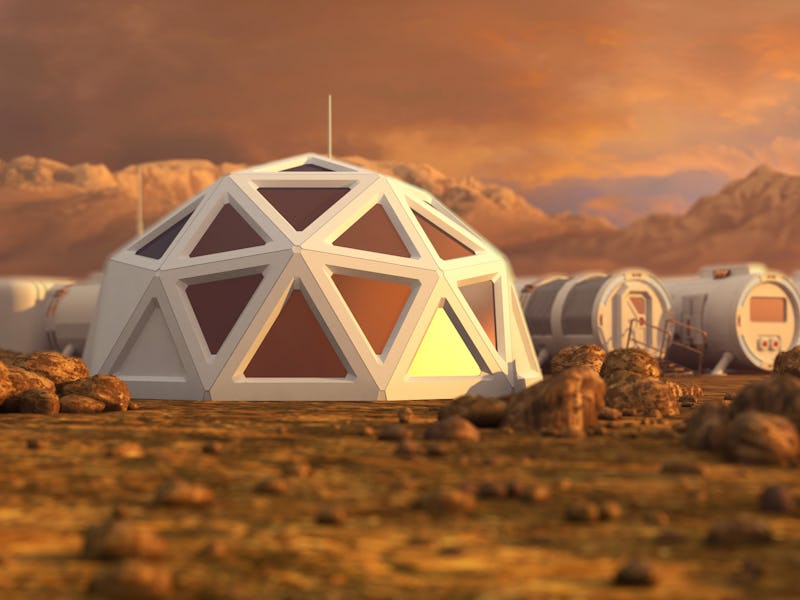This strange biomaterial could be the basis of homes on Mars
The future of extraterrestrial engineering lies in this abundant organic polymer.

Sustainability and closed-loop manufacturing are becoming an increasingly important topic for Earth-based manufacturing, but a new study has shown that these same principles can be lifted to model extraterrestrial travel as well.
Using a ubiquitous, organic polymer called chitin, found in everything from fungi fibers to shellfish shells, a team of researchers from Singapore has devised a low energy manufacturing material called "biolith." It uses Martian regolith — a loose mix of deposits that covers solid rock — and a chemically transformed solution of chitin to create a resilient, multi-use building material.
Able to do everything from creating tools to building colony structures, a polymer like this may be the future of extraterrestrial engineering.
In their study, published Wednesday in the journal PLOS ONE, the researchers explain that chitin, which is the second most prevalent organic polymer on Earth (right behind cellulose), was a prime choice for their experiment because it can be expected to be found in nearly any ecosystem. They say argue this is especially true in an extraterrestrial environment where insects may be utilized as a sustainable protein source for early settlers.
"Insects specifically have been identified as a key part of a potential Martian settlement as a high-yield protein complement to fulfill the caloric requirements of a human crew and to process agricultural and biological waste," write the authors.
This low-energy manufacturing material could be the future of space engineering.
While the flesh of insects may become a snack-time staple, the authors say that the exoskeletons' chitinous polymers actually have little nutritional value — making repurposing this byproduct as a manufacturing tool the perfect closed loop.
"In contrast to all biomolecules used to produce bioplastics, the extraction of chitin does not hamper or compete with the food supply; rather, it is a byproduct of it," the researchers write.
To see for themselves how well this organic polymer might actually work on the red planet, they put it to the test in the lab.
How'd they do it — To create this multi-use polymer solution, which the team called "biolith" as a play on the Martian surface's regolith, they combined chitin and 1 percent acidic acid to create a liquid chitin solution.
An acid like this would be achievable on Mars using a process like electrolysis, the team writes. To that solution, they then added a Martian regolith stimulant to create the final biolith solution.
In addition to being low-energy to create, this biolith solution could also serve as a polymer for three different engineering solutions — filling and sealing cracks, casting materials, and in additive manufacturing (like 3D-printing.)
The research team created a biolith wrench using a casting model.
Using this material the team was able to manufacture a wrench that could tighten a bolt with the same amount of torque as a traditional wrench.
The team also 3D printed a miniature NASA-inspired colony structure to demonstrate the way a scaled use of this polymer could be used to manufacture full colonies on Mars or the moon. While the habitat looks more like a terracotta scent diffuser than a sophisticated colony dwelling in its miniature form, the researchers hope that this material could be used in the future to design full-scale, livable colony structures as well.
Javier Fernandez, a material scientist at the Singapore University of Technology and Design and the study's lead author, said in a statement that this approach to sustainable manufacturing will hopefully create a "new paradigm in manufacturing."
Looking forward — NASA and commercial space companies alike have their eye on creating extraterrestrial colonies in the next decade, and wasteful, inorganic manufacturing like we're used to on Earth isn't going to cut it in an environment so far from home.
Using what we've learned in recent years about sustainability and zero-waste living, the researchers behind this paper hope that material like biolith could offer a new way to live sustainably — both on this planet and off.
"The results presented here demonstrate that the development of a closed-loop, zero-waste solutions to tackle unsustainable development on Earth may also be the key to our development as an interplanetary species."
Abstract: Given plans to revisit the lunar surface by the late 2020s and to take a crewed mission to Mars by the late 2030s, critical technologies must mature. In missions of extended duration, in situ resource utilization is necessary to both maximize scientific returns and minimize costs. While this present a significantly more complex challenge in the resource-starved environment of Mars, it is similar to the increasing need to develop resource-efficient and zero-waste ecosystems on Earth. Here, we make use of recent advances in the field of bioinspired chitinous manufacturing to develop a manufacturing technology to be used within the context of a minimal, artificial ecosystem that supports humans in a Martian environment.
This article was originally published on